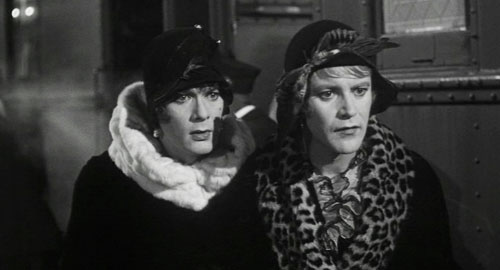Ruby Catherine Stevens (aka “Barbara Stanwyck”) was born 113 years ago, on July 16, 1907. She had a very difficult childhood. At the age of 4, Ruby lost her mother to a streetcar accident. A drunk pushed her mother, then pregnant, off a moving streetcar. She subsequently miscarried, and died from the complications. Two weeks after Ruby’s mother’s funeral, her father joined a work crew digging the Panama Canal, bailed on his children, and was never seen again.
Ruby and her older brother, Byron, were taken in and raised by their eldest sister, Mildred. When Mildred obtained a job as a showgirl, Ruby and Byron were placed in foster care. Ruby ran away often from the multitude of foster homes she was placed in. In 1916 and 1917, when she was 9 and 10, Ruby spent her summers touring with her sister Mildred. It was this period in her life that influenced Ruby’s decision to pursue acting. At the age of 14, Ruby dropped out of school and started working.

In 1923, Ruby started her career as a chorus girl at the Strand Roof, the club on top of the Strand Theater in Times Square. She also spent two seasons as a dancer in the Ziegfeld Follies. In 1926, through her chorus girl work, Ruby was discovered and asked to play a chorus girl in the upcoming Broadway play, The Noose. The Noose was very successful, running for over nine months! It was during this period when Ruby Catherine Stevens received her new stage name: Barbara Stanwyck.
After a couple years being a star on Broadway, Barbara screen-tested for the 1927 silent film, Broadway Nights. She did not win the leading part, but did make her screen debut, as a fan dancer, in the film. In 1929, Stanwyck appeared in her first sound film, The Locked Door. In 1930, Frank Capra selected Barbara for the lead in his film, Ladies of Leisure. This film served as the catalyst for Barbara’s film career. Between 1930 and 1933, Barbara starred in many memorable pre-code* films: Night Nurse (1931), So Big! (1932), and The Bitter Tea of General Yen (1933).
*Pre-Code refers to the period between the advent of sound pictures (1929) and the implementation of the Hayes Production Code (mid-1934). Pre-Code films are known for their racy, controversial themes. Many of these films deal with premarital sex, abortion, promiscuity, violence, homosexuality, and many other themes.
In 1933, Barbara was on a roll, careerwise. This is the year she would make her star-making film, Baby Face. Just before Baby Face, however, Barbara appeared in one of my favorite pre-code films: Ladies They Talk About.

Full disclosure, I love movies about ladies in prison. Well, actually I should amend that to I love seeing older films about ladies in prison. Some of the newer, more exploitative women in prison films, I wouldn’t have an interest in. In Ladies They Talk About, Barbara plays Nan Taylor, the sole female member of a gang of bank robbers. At the beginning of the film, Nan poses as a regular customer and distracts the security guard while her accomplices rob the bank. She ends up being arrested by a cop who recognizes her from a previous arrest. Nan is sentenced to prison and placed in the San Quentin State Prison.

San Quentin State Prison is an interesting place. The women are housed on one side, the men on the other. There is only a wall separating the two groups. On the ladies’ side of the prison, the women are given cute uniforms. Nan’s prison uniform is of course tailored to her perfectly and shows off her great figure. The prison also gives each woman her own cell, which she’s allowed to decorate to her liking.
The ladies play cards, do each others’ hair, and pursue other activities to pass the time. Meanwhile, Nan’s accomplices, the men, are housed on the other side of the prison, directly on the other side of the wall. Lefty, one of the members of Nan’s gang managed to avoid arrest. Through their weekly visits, Lefty and Nan scheme to break herself and Don (housed in the men’s prison) out. Nan is tasked with drawing a map of the layout of the women’s prison and making an impression of the matron key.
Getting the impression of the matron’s key is absurdly easy, as the matron (Ruth Donnelly) basically does everything but make the impression herself. Nan talks the Matron up about her key ring and the Matron lets her see each and every key, and provides details as to which key goes to which lock. With all the necessary tools in place, Nan and Don are ready to make their escape.

This movie is a lot of fun. Besides the ridiculous women’s prison, you can’t go wrong with an escape from prison plot. Stanwyck is fantastic as are the supporting cast members. I also love the Matron’s cockatoo. This film isn’t nearly as stressful or sadistic as Caged! (1950), which I also loved. Donnelly’s Matron is an absolute saint compared to Hope Emerson’s portrayal that will come 17 years later. There is a scene where a woman prisoner sings a love song to a photograph of Joe E. Brown. Joe E. Brown!
This movie has a strange ending. I won’t divulge it here. After watching it though, you’ll think: “What was that ending?”
So far, this film only seems to be available on the 5th volume of the Forbidden Hollywood collection.







